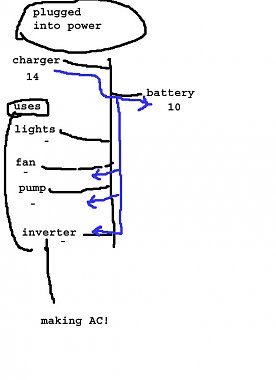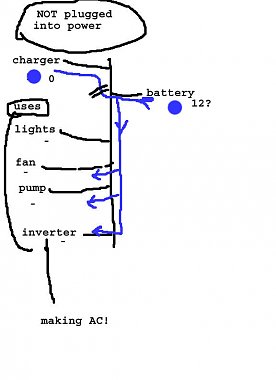Sometimes we are prone to not reading what the other person is writing, so excuse me please if I am getting the wrong idea. But I have a bit different view on batteries than we often talk about.
We often thing of power going to a battery and then THROUGH it, but I think of it as more like a storage tank, if we were speaking of water. Water and power do work a lot alike-- as long as we do keep them seperated!
What I am getting at is that when we have any form of power setup, the power, by definition, moves from higher voltage to lower.
When we have anything to charge like a converter, it is expected to bput out a higher voltage like 13-14 volts and that makes the current "run downhill" to any battery that has a lower voltage.
Newer charging systems are designed with "smarts" enough to know when the battery voltage is low or higher and near reaching optimum storage levels. So they may start off putting out 14 volts into a really low battery as it will charge faster but as it reaches full the charge voltage backs down to not over charge the battery.
It may be just a way we tend to think of batteries as we put power in and then take it out of the other end??
I see it more like this when we are plugged into power!
We have some form of charger like the converter and it puts out higher voltage than the battery, so some power will go that direction but also power will go to anything using power, like lights, fans and also the inverter if it is turned on. But that power will be coming from the charger as the higher voltage and practically none from the batteries as they will be low and taking power in, rather than out!

But if we unplug and leave all the user items turned on and the same, we find the power will still run from the highest point to the lower points.
The converter is somewhat like disconnected/turned off, so that path is gone but the path from the battery ( say 12Volts?) will then be the higher voltage point and power runs from it to anything using power (Negatives?)

It is usually a good idea to only turn the inverter on when we are NOT plugged in but we need 110AC for some use. It does use some battery power for the internal components even if we are not actually using any 110 AC power, so just saves some battery if we turn it off.
But if we turn it on, the inverter will use battery and we DO have AC power!
I think of the battery as simply storage and that means we put power in when we have lots of 12VDC, like when charger is running but take it out if there is no better/ higher voltage available.
It is not that the charger puts it in the battery and things we have turned on take it out of the battery but the power comes from the higher voltage that is online!
Just a bit different thinking but it makes it show that the battery is not "working any harder" under either condition.
But it is true that the battey WILL go dead quicker if we are not pluged in and the inverter is left alive---even if we are not meaning to use any AC power. The inverter components do use some power.
Same with the little wall wart chargers for phones, etc. ? When we leave them plugged into the AC outlet, they are setting there using power, pretending to make DC power, even if the phone is not connected to the cord!

On the good new chargers, when it reaches the optimum voltage on all parts of the setup, it automatically backs the voltage down to what is called float level, just a bit above 12. 8 that is the natural voltage of the chemicals in a fully charged lead acid battery.